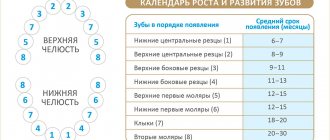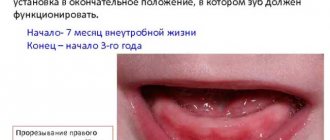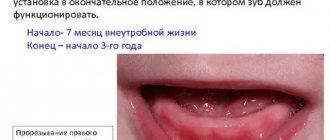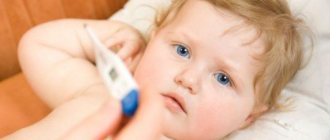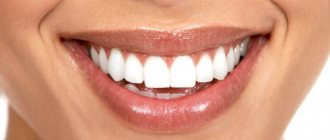There are happy parents and children who may not even notice how a new tooth has appeared in the child’s mouth. But still, more often than not, when teething, both the baby and the parents are equally worried and do not sleep at night. In some cases, the baby’s temperature can rise to 39 degrees; it is imperative to react to such a high temperature. Parents need to know what to do in such cases and when to use professional medical help without trying to self-medicate.
What causes fever to rise during teething?
Contrary to the popular belief of parents, an increase in temperature on the teeth is not the norm and does not always accompany teething. In this way, the baby’s fragile body responds to the occurrence of an inflammatory reaction in the gum, through which the first tooth makes its way. In this place, immune defense is reduced, microorganisms living on the mucous membranes are activated - this also provokes temperature surges.
This process is most difficult after a year, when fangs or molars are being cut, since the chewing teeth have several tubercles that cannot appear simultaneously and the process sometimes drags on for up to several weeks. The “eye” teeth are located slightly deeper than the others and must travel a longer path to the gum surface. Therefore, children usually experience quite severe discomfort and prolonged rises in temperature when they appear.
Sometimes fever during this period of life is a sign of an acute infection, which is due to reduced immunity. In this case, the body tries to protect itself from the invasion of viruses or bacteria and increases the temperature, which is destructive for pathogens.
What is the maximum temperature possible during this period?
How much the temperature rises when a baby’s teeth appear depends only on his individual characteristics. On average, this figure is 37.5-37.7 degrees. Sometimes this figure can reach 38 - this is also an acceptable value. It is important to take regular measurements, since infants do not regulate heat exchange well and as inflammation progresses, the temperature can increase very quickly.
A higher temperature (39-40 degrees) may indicate complications, the development of a respiratory tract infection and requires immediate medical attention.
How many days does it last
In answering this question, it should again be recalled that all children are different and react differently to the appearance of teeth. On average, fever in babies can last 1-3 days and usually disappears immediately after teething.
But in the experience of many pediatricians, there are children whose high body temperature associated with the appearance of their first teeth lasted up to 4-5 days. Or there are cases when the fever lasts only a few hours and goes away without any intervention. In any case, you should not delay consulting a doctor, since if you have any diseases, identifying them earlier has a more favorable outcome.
Anxiety, digestive and sleep disorders
At 6-8 months of life, children begin to erupt milk teeth. Swollen gums cause discomfort, causing the child to put everything in his mouth, trying to relieve the itching. For most children, the process of the appearance of their first teeth is hectic, which manifests itself:
- sleep disturbance;
- sore gums and refusal to eat;
- runny nose and excessive salivation;
- possible disruption of bowel function;
- and, most unpleasantly, temperature during teething.
Of course, not all children experience the above symptoms. For some, the process of formation of the masticatory apparatus goes almost unnoticed. But quite often the child’s body reacts to the appearance of the first incisors, fangs and molars as if it were an inflammation. This can cause a child to develop a fairly high temperature on the teeth, against the background of which other disorders also arise in the small body.
Other symptoms accompanying fever
During teething, there may be other symptoms in addition to fever. Swelling of the gums can spread from the oral cavity to the nasal mucosa, thereby causing a slight runny nose and the discharge of a slight transparent mucous secretion. This symptom is more pronounced when the upper teeth erupt.
The appearance of baby teeth is often accompanied by excessive salivation, especially when the lower teeth erupt. This also causes a slight loosening of the stool - the stool becomes a little softer than usual.
What should parents be wary of?
A child's body, weakened by teething, is very susceptible to bacterial or viral infection. Therefore, the baby’s symptoms may indicate complications:
- Severe nasal congestion , accompanied by copious discharge of purulent secretion. This suggests that on top of the usual swelling of the mucous membrane there is rhinitis, which must be treated.
- Loose stools . Fever and diarrhea together rarely accompany the appearance of teeth. This symptom may indicate the presence of some kind of intestinal infection, which the child could have introduced into the body with toys or gum teethers.
- Cough . With excessive salivation, children do not always have time to swallow saliva in time and sometimes choke on it, which causes periodic coughing. If the cough is systematic, accompanied by difficulty breathing or sputum discharge, then this speaks in favor of inflammation of the respiratory tract.
- Red throat . The inflammatory reaction that occurs in the gums during teething cannot spread to the mucous membranes of the throat. Redness of the palatine arches or pharynx is a sign of pharyngitis or acute respiratory infections.
- Vomiting often accompanies high body temperature in young children. But it may be a sign of damage to the nervous system or intestinal infection.
The presence of such signs requires urgent medical attention and appropriate treatment, regardless of what temperature (high or low) accompanies them.
Prevention measures
It is important for mothers to remember that a child’s health begins in the womb.
After all, the baby’s teeth are formed during pregnancy. It has long been proven that the more the expectant mother takes care of her health during pregnancy, the stronger her child’s teeth will be. Doctors advise pregnant women to eat seafood, milk, kefir, and cheese. If a gynecologist advises you to buy a special vitamin complex containing calcium, you should not neglect this advice. A lack of calcium in a child’s body causes dental problems. Caring mothers go through life with the correct motto “a happy baby is a healthy baby.” This article is for informational purposes only, please consult your doctor for details! Ask your doctor about contraindications and side effects.
Temperature during loss of primary teeth and eruption of permanent teeth
The replacement of baby teeth with molars is usually not accompanied by any temperature reactions. An exception may be chewing teeth, which have a large surface and cause significant inflammatory reactions in the gums.
In addition, an increase in temperature during teething in a fairly old child (6 years of age or more) may indicate the presence of gingivitis - a disease of the gingival mucosa, which can lead to serious consequences without treatment.
When to lower the temperature
There is no need to lower the temperature to 38.5°C. If it rises higher, you need to take action. Hyperthermia affects many processes in the human body. During fever, the water-salt balance is disrupted and the load on the heart increases. In severe cases, convulsions may occur that can lead to respiratory arrest. In no case should this be allowed to happen, as this would pose a threat not only to the health, but also to the life of the little patient.
- How many days does a baby's teething temperature last?
When to give antipyretic drugs:
- temperature exceeded 39°C;
- breathing rate increases;
- the baby sleeps for a very long time;
- the child is restless, cries, cannot calm down;
- drying of mucous membranes, redness of the skin;
- the occurrence of convulsions (in this case, they give an antipyretic and immediately call an ambulance).
If the child has already had convulsions once, the temperature must be brought down when it exceeds 38°C.
What to do when the temperature rises
Often parents, even with a slight fever, begin to actively treat the child with antiviral, antipyretic and antibacterial drugs. Even if this symptom is due to the appearance of the first teeth. Most pediatricians (including Dr. Komarovsky) are against such radical methods. Why shouldn't you do this?
A temperature of 37 degrees and above is a kind of protective reaction of the body and helps it more actively produce antibodies against viruses and bacteria. Low body temperature does not allow you to effectively fight infection. Therefore, sometimes it is worth not interfering with natural processes and immediately suppressing even minor signs of fever.
But you shouldn’t fall into inaction either. If the fever reaches significant numbers (38 degrees or higher) and is accompanied by a change in the general condition of the child, then prescribing antipyretic drugs for high fever is a primary measure.
If the rise in temperature is not controlled by conventional medications, then it is possible to scrub the child with cool water or an vinegar-alcohol mixture.
If the fever does not subside within 3 days, then you must definitely visit your treating pediatrician to decide on further examination and the possibility of prescribing antibiotics or other medications.
Some parents prefer homeopathy in such cases. Such drugs do not effectively reduce the temperature, but they can alleviate the baby’s general condition and speed up the recovery process. A prerequisite before taking homeopathic medicines is to consult a specialist.
How to help your child during teething
The period of teething is considered difficult for the baby and requires special indulgence, attention and care for him. Therefore, it is important to help your child get through this difficult time for him. The process of cutting through the fangs located in the top row can be called especially painful. After all, they are located near the facial nerves. When the top row of canines erupt, tears actively flow from the baby’s eyes. His parents notice that he has some symptoms of conjunctivitis.
Now in children's stores and pharmacies you can buy toys - teethers, produced specifically to facilitate the process of cutting fangs. Manufacturers fill them either with water or use a gel for this purpose. The purchased toy can be placed in the refrigerator for a few minutes and cooled; it will soothe the baby’s gums and relieve itching. Parents will also benefit from pacifiers that the baby can chew; it is better to choose arthodontic ones. You can also buy special medications at the pharmacy that relieve some symptoms. For example, a gel with an anti-inflammatory effect, which ultimately reduces the baby’s pain. But you should not select any medications on your own without first consulting a specialist. If the child’s temperature rises to 38 degrees Celsius, then after consultation with the pediatrician, you can give him medicine with paracetamol. Ibuprofen may be a good alternative. These medications are considered safe for the baby and effectively fight fever. For children under 3 years old, it is better to buy medicines in the form of suppositories or syrups. Suppositories have an effect slower than syrup, but their effect lasts longer.
Is it possible to walk with a child with a fever?
If the baby’s general condition does not suffer much during teething, and the temperature is not high and is well controlled by antipyretic drugs, then a walk may even be beneficial. The main thing is to dress your child according to the weather, try to stay away from other children (since you can easily catch an infection) and not tire your baby with active outdoor games.
If the fever reaches high levels and the child does not tolerate it well, then it is better to refuse a walk until the condition improves.
In any case, even if parents are sure that the increase in temperature is caused by teething, medical consultation is necessary. You should not self-medicate, since incorrect measures will not only not alleviate the baby’s condition, but can also harm his health.
How to determine by symptoms that a child is getting his first fang
Symptoms can be detected much earlier than the baby’s first fangs appear. Usually parents notice them a few weeks before the teeth erupt, but there are also cases when symptoms appear even earlier. How can you tell if your child is growing fangs?
- The baby becomes irritable, his mood changes for the worse. He is capricious and crying.
- Parents notice strong salivation, sometimes leading to a runny nose or causing a cough.
- The gum swells and changes color where the fang erupts. The fang first appears as a small white dot located under the baby's gum.
- The child does not want to eat, sometimes he categorically refuses to eat.
- The baby doesn't sleep well.
- He often chews on various objects, trying to make them come into contact with his gums.
In addition to the above signs, parents may also observe an increase in temperature when the child begins to grow fangs. In some cases it rises to 38 degrees Celsius. The baby's stool becomes liquefied due to increased salivation. Excessive salivation also leads to vomiting.
